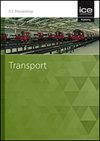绿色建筑泡沫混凝土墙体材料承载力研究
IF 1.2
4区 工程技术
Q4 ENGINEERING, CIVIL
Proceedings of the Institution of Civil Engineers-Transport
Pub Date : 2023-11-14
DOI:10.1680/jsmic.23.00017
引用次数: 0
摘要
本研究利用轻钢结构墙体骨架和泡沫混凝土组合墙体,设计了4组不同泡沫混凝土密度(FC)和含钢量墙体的应变试验,并利用有限元软件分析了墙体参数与抗剪强度的关系。在位移结果中,FC密度越高,其承载能力越高。当泡沫混凝土密度为1000kg / m3和1600kg / m3时,墙体在最大荷载分别达到80kn和90kn后将失去承载能力。试件轴压比越大,组合墙抗剪能力越大。当位移距离为30 mm时,剪跨比分别为1.0、2.0、3.0和4.0时,最大荷载为162 KN、110 KN、94 KN和85 KN,承载力随剪跨比的增大而减小,与剪跨比为1.0时相比,承载力分别下降了23%、41%和51%。当密度为800、1000、1200和1600时,组合墙的最大荷载分别为88 KN、79 KN、81 KN和62 KN;当钢含量比分别为0.5、1.0、1.5、2.0、2.5时,分别为75、80、81、94、101 KN。含钢量越高,墙体承载力越大,期望本研究获得的参数及墙体承载力变化规律能为建设工程提供一定的参考依据,加快绿色建材的实现。本文章由计算机程序翻译,如有差异,请以英文原文为准。
Research on the bearing capacity of foam concrete wall materials in green buildings
The study fabricated a combined wall with the help of lightweight steel structural wall skeleton and foam concrete and designed four sets of strain experiments for walls with different foam concrete densities (FC) and steel content, and analysed the relationship between the wall parameters and shear strength with finite element software. In the displacement results, the higher the density of FC, the higher the load-bearing capacity. When the density of foam concrete is 1000 kg/m 3 and 1600 kg/m 3 , the wall will lose its load carrying capacity after a maximum load of 80 KN and 90 KN respectively. The greater the axial compression ratio of the sample, the greater the shear capacity of the combined wall. When the displacement distance is 30 mm, the maximum load is 162 KN, 110 KN, 94 KN and 85 KN when the shear span ratio is 1.0, 2.0, 3.0 and 4.0 respectively, and the load carrying capacity decreases with the increase of the shear span ratio, and compared with the shear span ratio of 1.0, the load carrying capacity decreases by 23%, 41% and 51% successively. The maximum loads of the combined walls were 88 KN, 79 KN, 81 KN and 62 KN when the densities were 800, 1000, 1200 and 1600, respectively; and 75 KN, 80 KN, 81 KN, 94 KN and 101 KN when the steel content ratios were 0.5, 1.0, 1.5, 2.0 and 2.5, respectively. The higher the steel content, the greater the bearing capacity of the wall, it is expected that the parameters obtained from this study and the change rule of wall load carrying capacity can provide a certain reference basis for the construction project and accelerate the realisation of green building materials.
求助全文
通过发布文献求助,成功后即可免费获取论文全文。
去求助
来源期刊
CiteScore
2.60
自引率
0.00%
发文量
42
审稿时长
5 months
期刊介绍:
Transport is essential reading for those needing information on civil engineering developments across all areas of transport. This journal covers all aspects of planning, design, construction, maintenance and project management for the movement of goods and people.
Specific topics covered include: transport planning and policy, construction of infrastructure projects, traffic management, airports and highway pavement maintenance and performance and the economic and environmental aspects of urban and inter-urban transportation systems.

 求助内容:
求助内容: 应助结果提醒方式:
应助结果提醒方式:


